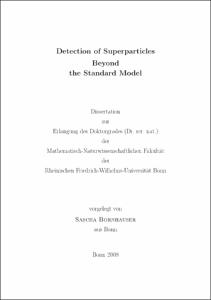Online-Ausgabe in bonndoc: https://nbn-resolving.org/urn:nbn:de:hbz:5N-14804
urn: https://nbn-resolving.org/urn:nbn:de:hbz:5N-14804,
author = {{Sascha Bornhauser}},
title = {Detection of Superparticles Beyond the Standard Model},
school = {Rheinische Friedrich-Wilhelms-Universität Bonn},
year = 2008,
note = {
This Phd thesis deals with supersymmetric particles within the context of astroparticle and collider physics.
The first part is about the detection of UHE cosmic particles; it based on the use of the matter of Earth and Moon as detector volume, where in the case of UHE neutralino LSPs the Earth acts in addition as a filter against the background of UHE neutrinos. We present the solutions of the transport equations regarding UHE neutralino LSP and neutrino fluxes; these solutions are given for processes where the total cross section is dominated by t- or s- channel scattering. The last section of the first part provides the final formulas for the calculation of event rates with respect to the Earth, including the background of UHE neutrinos, and the Moon. Here, we are taking into account the energy loss of tau leptons in matter, before they decay back into neutrinos.
We then find detectable event rates in experiments of several teratons scale, like a future satellite experiment as EUSO or OWL only if the following conditions are satisfied: the lightest neutralino must be a higgsino, rather than a bino; the X particle must decay via a mode which results in a large ratio of neutralino LSP and proton flux; the X particle mass must be rather close to its lower bound ; the experiment must be able to detect Cerenkov light.
The second part deals with electroweak contributions, being the result of neutralinos and chargino exchange in the t- and/or u-channel as well as electroweak gauge bosons in the s-channel, to squark pair production at the CERN LHC. The reason for the partly sizable electroweak contributions is the interference between electroweak and QCD interactions. These contributions are most important for two final state SU(2) doublet (L-type) squarks; if one has at least one SU(2) singlet (R-type) squark, the change of the total cross sections decreases to only a few percent.
We found that higher squark masses give rise to higher relative electroweak contributions and a larger change of the total cross section, respectively. In case of two produced SU(2) doublet squarks this change can be a increase or reduction of the cross section by more than 50% if we consider: heavy squarks with masses of about 2 TeV, a scenario without gaugino mass unification and a absolute value of the SU(2) gaugino soft breaking mass near the squark mass.
Electroweak contributions can change the cross section for the production of two SU(2) doublet squarks by more than 30% in the case of scenarios with gaugino mass unification, if the squark masses are again near 2 TeV. Furthermore, the electroweak contributions peak at small transverse momentum of the produced squark, so it is not possible to subsume them in a constant k-factor.
url = {https://hdl.handle.net/20.500.11811/3647}
}






